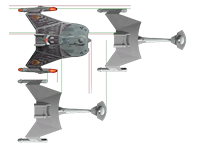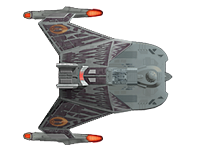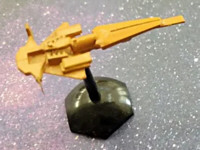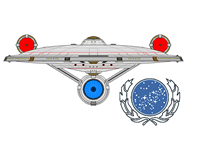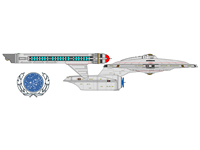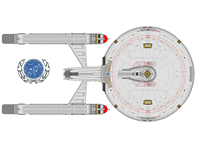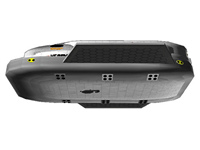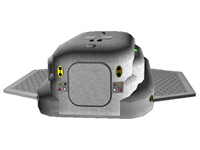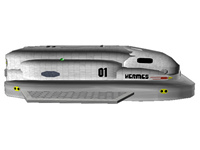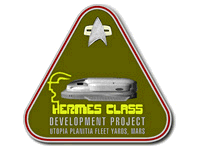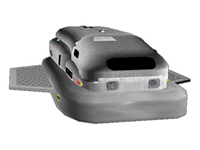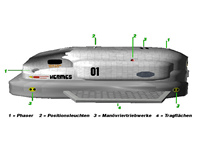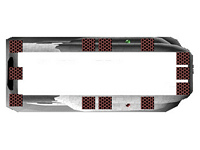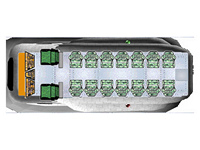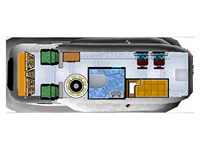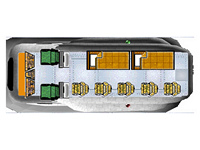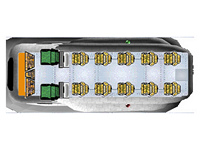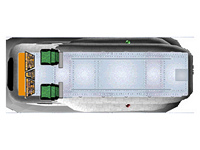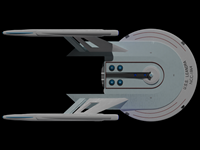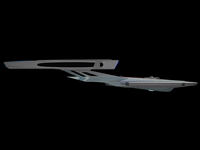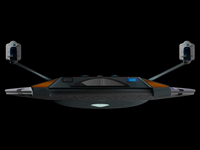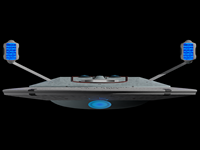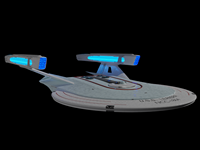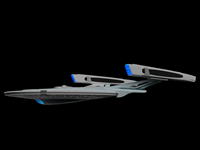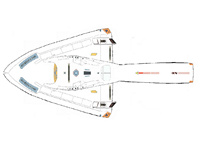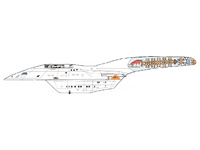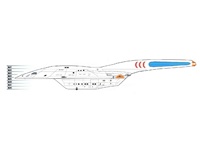Recent Additions
The most recently added designs at a glance. See also: Previous Additions.
Bajoran Battlecruiser 
Design by Syckoson
Affiliation: Bajoran
Type: Light cruiser
First commissioned: 2377
Length: 200m
Width: 180m
Height: 66m
The Bajorans did well financially after the Dominion War. They became a trading hub between the Alpha and Gamma quadrants. This meant they had to protect their assets. They were working on a peace and eventually trade treaty with Cardassia but in the mean time they struck a deal with the Klingons and Ferengi to procure old D7 class ships and heavily armored freighter hulls modified to act as a light cruiser. Now the most aggressive and dangerous ship in their fleet the pirates and other groups had to take them seriously.
Using D7 Mk 3 hulls. Sections from k24 that were not needed after being upcycled and a custom bridge and fore section by the Ferengi. The warp nacelles and nacelle mounted weapons were upgraded to those used on the Klingon battle barge and K24 respectively. While no match for a Vor'cha or Negh'var on its own, in a pack these can be extremely dangerous. Packing modern weapons on an agile and tried and tested platform they are likely the most powerful D7 variation to date. Two of these would easily overwhelm a Galor or Keldon, and they are always found in packs. Like the Bajoran Hara Cat they are fast, graceful and deadly.
Thanks to Atolm for the warp Nacelles and Paramount/CBS for the cool D7 and Merchantman designs.
Cardassian Lelaug Class 
Design by Aaron Hamilton
Affiliation: Cardassian
Type: Cruiser
First commissioned: 2240
Length: 229m
Displacement: 63100t
Armament: Phasers, spatial torpedos
These ships were used in advanced close-formation tactics to coordinate firepower vs individually stronger opponents. Squadrons of this type suppressed Klingon incursions, defeated Degrar battle fleets in two major wars in 2246 and 2261, and wiped out the armed Orion colony at N'rutoka in 2258. The design dispensed with easily-jettisonable nacelles to expedite production of ships.
Background: The Cardassians have been established as a rival to the Federation, Klingons, and Romulans, so I wanted to show how their ships developed before their first war with the Federation (pre-TNG). The Cardassian technology seems a step behind the Federation's and so they relied on tightly controlled formations of cruisers like these. This TOS-era ship, probably ranking in power between a Klingon D4 cruiser (FASA version) and D16 destroyer, has exposed deflector generators and nacelles embedded in the forward hull. It is called the Lelaug class. I add an extra enemy for the historic Cardassians to overcome in the Degrar, a species distantly related to the Anticans that had a coreward empire peaking in strength in the 1920s-2050s but broken up by 2310, Earth CE years.
More custom miniatures ships.
Coalition Class 
Design by Eric L. Gardner Jr
Type: Cruiser
First commissioned: 2190
Length: 292m
Width: 144m
Height: 57m
Decks: 14
Displacement: 85000t
Complement: 100 officers + 83 crew, evacuation limit: 75
Speed: Warp 6 (cruise), Warp 7 (max.), Warp 8 (max. emergency)
Sublight speed: 0.99c (max.)
Armament: Phased cannons, pulse cannons, photon torpedoes
Defense: Polarized hull plating, deflector shields, tractor beams
Embarked craft: Shuttlepods, escape pods, experimental long-range shuttlecraft
Built in the 2190's, the Coalition-class was Starfleet's latest starship design taken from and used parts of one of the proposed refits of the NX (later renamed Explorer) class. There were other ships of this design in service, including the U.S.S Yamato (launched in 2199). In 2205, the Coalition herself came under attack by an Romulan prototype warbird launched by those to refuse to accept the outcome of the war in Earth's favor. The Coalition was left adrift until a few of the Daedalus-class ships (the lead vessel being the Essex) towed their savior back to Earth. The Coalition was damaged beyond and was sent to be scraped...but the design itself would ultimately pave the way to more advanced ship designs.
The Coalition class would last until the 2240's when the Four-Year War with the Klingons began to attack Federation convoys to nearby colonies. The remaining Coalition models were sold or decommissioned by Starfleet to pave the way for a new starship design - a heavy cruiser that would later become Starfleet's beloved symbol of space exploration: The Constitution-Class.
Hermes Class 
Design by Chadic Garou
Type: Planetary vehicle, glider
First commissioned: 2397
Length: 8.06m
Width: 5.87m
Height: 2.20m
Decks: 1
Displacement: 7.15t
Complement: 1 officers + 1 crew, evacuation limit: 23
Armament: 2x phaser type V (bow), 1x phaser type V (stern), 2x microtorpedo launchers with 30 microtorpedos each
Defense: ./.
Embarked craft: ./.
- Project management: Commodore Chadic Garou (CG)
- Co-Worker: Lt.Commander Randy Smith (RS), Commander Iliak J'Nai (IJ)
- Design: CG
- Technology: RS, CG
- Basics: RS, IJ, CG
The design can be transported in a special module in a Glikar'ma-class runabout or by larger ships, dropping into the atmosphere. Resumption is possible with the help of the tractor beam emitter.
The aerodynamic shape and an anti-gravity cushion ensure buoyancy. Entry and exit are via the stern hatch, which also serves as a ramp. There is an emergency exit in the roof of the cockpit.
The speed that can be achieved depends on the density of the atmosphere; at higher altitudes, almost the speed of sound should be possible. The anti-gravity cushion is used to maneuver in slow flight. The glider can take off and land vertically thanks to its many maneuvering nozzles. The anti-gravity cushion provides better traction when flying at a height of 3-10 m above a planetary surface, which should be the standard height for most missions. On Minshara-class planets, however, the service ceiling can be around 40,000 m. Stubby wings ensure better lift and maneuverability from heights of over 1,000 m.
The drive and the complete energy supply are provided by Sarium Krellid cells. Without a fusion reactor, the energy signature is so minimal that almost an effect similar to that with active camouflage is achieved. In addition, the drive is whisper-quiet and can take it with:
- any wheeled or tracked vehicle
- every planet-bound aircraft
- every ship, as the surface is rather unimportant for gliders
- many gliders based on other drives.
The cabin, consisting of the cockpit and cargo / passenger area, is hermetically sealed. The consoles for the pilots are in the cockpit, two further consoles in the cargo / passenger area can be equipped / programmed. The cargo / passenger compartment can be converted from passenger to cargo transport in a short time - and back. There are also two pallets on the side of the fuselage, which can be quickly exchanged and specific to the mission with appropriate sensors or similar can be equipped. A load hook system on the underside not only enables the gripping of lighter items such as weather balloons - which are difficult to handle with a tractor beam - but also enables cargo to be picked up and transported overboard.
- Dimensions length / width / height: 8.06 / 5.87 m / 2.20
- Empty weight: 7,145 mT, payload: 1,300 mT
- Cruising speed: 200 km / h (low flight) / 600 km / h (flight at altitudes over 1,000 m)
- Maximum speed: 925 km / h for 6 hours (at altitudes of 10,000 m and above)
- Armament: 2x phaser type V (bow), 1x phaser type V (stern), 2x microtorpedo launchers with 30 microtorpedos each.
Mission types:
- (B) people * - / (C) wounded and (A) cargo transport ** (civil and military, open or covert use)
- (D) Planetary reconnaissance, surveying, surveillance (civil and military, open or covert use)
- Use of fertilizers in agriculture with appropriately prepared microtorpedos (civil, open use)
- (C) Search & Rescue missions (civil and military, open or covert)
- (D) Research missions (civil and military, open or covert)
- (E) Command missions (military, usually covert)
- (C) Dropping and picking up agents (military, covert operations)
- Defense against enemy ground and air targets within the atmosphere (military, open or covert use)
Mission duration: Two to three days without charging the Sarium Krellid cells, which are housed in 13 blocks. Additional energy is generated via a photovoltaic system in the wings.
* Passenger transport usually for 2 + 10 people
** The center aisle must remain free for freight transport, as the stern ramp is the standard exit.
Interior:
- A - freight transportation
- B - Passenger transport for up to 10 people
- C - Ambulance transport for 2 lying injured and up to 4 ambulatory injured. Transportable bio beds (TBB) can also be used instead of normal beds
- D - Surveyor - with toilet, computer core, food replicator, 2 bunk beds, 2 operator places.
- The mission can be extended to 4-8 days.
- E - troop transport - for up to 14 soldiers with standard equipment
Thanks to Lt.Commander Randy Smith, Commander Iliak J'Nai.
Leandra Class 
Design by Evan Gill
Type: Medium patrol vessel
First commissioned: 2285
Length: 278m
Width: 133m
Height: 48m
Decks: 12
Complement: 24 officers + 246 crew, evacuation limit: 124
Speed: Warp 6.4 (cruise), Warp 8.75 (max.), Warp 9.1 (max. emergency)
Sublight speed: 0.25c (max.)
Armament: Five double port phasers, two fore photon torpedo tubes.
Defense: Standard hull plating,
Embarked craft: One work bee, three shuttles
A smaller vessel than its peers the Constitution refit and the Excelsior. Designed specifically as a low cost patrol and interceptor for the fleet.
To save resources and construction time, the Reacher class only has one window. Furthermore, the standard nacelles are a slightly earlier variation than those used by the refit constitution, with some vessels of the class being fitted with recycled nacelles from earlier vessels such as the Constitution class.
Lacking many of the scientific, diplomatic and cargo facilities as it's larger siblings, the Reacher class presents a very small silhouette for standard size engines and a relatively punchy armourment.
Sparrow Class 
Design by Benjamin Wilcox
Type: Explorer
First commissioned: 2385
Length: 160m
Complement: 15 officers + 65 crew, evacuation limit: 400
Speed: Warp 8 (cruise), Warp 9 (max.)
Armament: 7 Type VIII Phaser Arrays, 2 Forward Torpedo tubes
Defense: Regenerative shields, Ablative hull armor
Embarked craft: 3 Shuttle craft
In the late 24th century, advances in Warp field theory, and subspace dynamics gave rise to a new form of Starship warp drive using an articulated warp coil assembly. These advances led to the creation of the Sparrow class starship. The sparrow class is designed to provide deep space exploration capiblities is a smaller space frame, with a smaller crew. The design has features similiar to the deiant class and nova class starships, with a few exceptions. The shuttle bay is in the forward hull 2 decks down from the bridge. This was done to facilitate the articulated warp coil assembly.
T'Sel Class 
Design by Michael jolly (voron)
Type: Light Exploratory cruiser
First commissioned: 2259
Length: 280m
Width: 100.9m
Height: m
Decks: 8
Displacement: 155000t
Complement: 70 officers + 210 crew, evacuation limit: 200
Speed: Warp 6 (cruise), Warp 7.5 (max.), Warp 8.8 (max. emergency)
Armament: 7 (Type VI single mount) Phasers, 2 photon torpedo launcher
Defense: Standard defensive shields
Embarked craft: 6 standard shuttlecraft
In the aftermath of Burnham's war and the 18 month conflict that devastated the fleet. Start fleet required a new explorer for full long range exploration. The first 12 Constitution classes had been completed with more under construction but a smaller lighter and fast vessel was required for secondary long to medium term missions of around 2 years. Using new technology and the largest centrifuge developed for the creation of the nacelles off the Constitution class.
A new class was developed with the intent of 2 years operation away from the Starfleet resources.
A concern from the Federation council and the Starfleet was the need to spread construction out from the main shipyards and to create a design that could be built in the words of Admiral T'Vel "efficiently, quickly and with quality among smaller yards". The lead Vessel was named USS T'SEL (Vulcan for Delta Lady) NX–1628 and started accelerated construction in December 2257 with 6 other ships starting in February 2258. Construstion on the lead vessel was completed by the next December the next year with trails starting over 2259.
The main components of this vessel are a new 5th generation duotronic long range sensor array and a brand new duotronic internal computer system.
The 100 meter diameter primary hull carried a updated bridge module, an enlarged sickbay, the duotronic computer core, extensive scientific laboratories, and Large berths for officers, crew, and diplomatic guests. All phaser emitter ports and torpedo tubes were concealed behind retractable hull plates. A large sensor in the ventral promontory allowed the vessel to scan deep below planetary surfaces from high in geosynchronous orbit. The impulse deck was of a new, High powered design it was larger than other deigns and allowed higher acceleration to sub-light speed and increased turning circle. Within the secondary hull were engineering spaces for the warp drive system, including the redesigned warp reactor, deuterium tanks, AM containment bottles, and plasma conduits. This large section of the hull was dedicated to cargo bays, workshops, fabrication printers, and recreation facilities.
With thanks to Edge of Midnight for inspiring the design.


